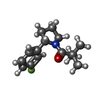Entry Database : PDB / ID : 6ocqTitle Crystal structure of RIP1 kinase in complex with a pyrrolidine Receptor-interacting serine/threonine-protein kinase 1 Keywords / / / Function / homology Function Domain/homology Component
/ / / / / / / / / / / / / / / / / / / / / / / / / / / / / / / / / / / / / / / / / / / / / / / / / / / / / / / / / / / / / / / / / / / / / / / / / / / / / / / / / / / / / / / / / / / / / / / / / / / / / / / / / / / / / / / / / / / / / / / / / / / / / / / / / / / Biological species Homo sapiens (human)Method / / / Resolution : 2.793 Å Authors Thorpe, J.H. / Harris, P.A. Journal : J.Med.Chem. / Year : 2019Title : Discovery and Lead-Optimization of 4,5-Dihydropyrazoles as Mono-Kinase Selective, Orally Bioavailable and Efficacious Inhibitors of Receptor Interacting Protein 1 (RIP1) Kinase.Authors: Harris, P.A. / Faucher, N. / George, N. / Eidam, P.M. / King, B.W. / White, G.V. / Anderson, N.A. / Bandyopadhyay, D. / Beal, A.M. / Beneton, V. / Berger, S.B. / Campobasso, N. / Campos, S. ... Authors : Harris, P.A. / Faucher, N. / George, N. / Eidam, P.M. / King, B.W. / White, G.V. / Anderson, N.A. / Bandyopadhyay, D. / Beal, A.M. / Beneton, V. / Berger, S.B. / Campobasso, N. / Campos, S. / Capriotti, C.A. / Cox, J.A. / Daugan, A. / Donche, F. / Fouchet, M.H. / Finger, J.N. / Geddes, B. / Gough, P.J. / Grondin, P. / Hoffman, B.L. / Hoffman, S.J. / Hutchinson, S.E. / Jeong, J.U. / Jigorel, E. / Lamoureux, P. / Leister, L.K. / Lich, J.D. / Mahajan, M.K. / Meslamani, J. / Mosley, J.E. / Nagilla, R. / Nassau, P.M. / Ng, S.L. / Ouellette, M.T. / Pasikanti, K.K. / Potvain, F. / Reilly, M.A. / Rivera, E.J. / Sautet, S. / Schaeffer, M.C. / Sehon, C.A. / Sun, H. / Thorpe, J.H. / Totoritis, R.D. / Ward, P. / Wellaway, N. / Wisnoski, D.D. / Woolven, J.M. / Bertin, J. / Marquis, R.W. History Deposition Mar 25, 2019 Deposition site / Processing site Revision 1.0 May 8, 2019 Provider / Type Revision 1.1 Jun 5, 2019 Group / Database references / Category / citation_authorItem _citation.journal_volume / _citation.page_first ... _citation.journal_volume / _citation.page_first / _citation.page_last / _citation.title / _citation_author.name Revision 1.2 Mar 13, 2024 Group / Database references / Category / chem_comp_bond / database_2Item / _database_2.pdbx_database_accession
Show all Show less
 Open data
Open data Basic information
Basic information Components
Components Keywords
Keywords Function and homology information
Function and homology information Homo sapiens (human)
Homo sapiens (human) X-RAY DIFFRACTION /
X-RAY DIFFRACTION /  SYNCHROTRON /
SYNCHROTRON /  MOLECULAR REPLACEMENT / Resolution: 2.793 Å
MOLECULAR REPLACEMENT / Resolution: 2.793 Å  Authors
Authors Citation
Citation Journal: J.Med.Chem. / Year: 2019
Journal: J.Med.Chem. / Year: 2019 Structure visualization
Structure visualization Molmil
Molmil Jmol/JSmol
Jmol/JSmol Downloads & links
Downloads & links Download
Download 6ocq.cif.gz
6ocq.cif.gz PDBx/mmCIF format
PDBx/mmCIF format pdb6ocq.ent.gz
pdb6ocq.ent.gz PDB format
PDB format 6ocq.json.gz
6ocq.json.gz PDBx/mmJSON format
PDBx/mmJSON format Other downloads
Other downloads 6ocq_validation.pdf.gz
6ocq_validation.pdf.gz wwPDB validaton report
wwPDB validaton report 6ocq_full_validation.pdf.gz
6ocq_full_validation.pdf.gz 6ocq_validation.xml.gz
6ocq_validation.xml.gz 6ocq_validation.cif.gz
6ocq_validation.cif.gz https://data.pdbj.org/pub/pdb/validation_reports/oc/6ocq
https://data.pdbj.org/pub/pdb/validation_reports/oc/6ocq ftp://data.pdbj.org/pub/pdb/validation_reports/oc/6ocq
ftp://data.pdbj.org/pub/pdb/validation_reports/oc/6ocq Links
Links Assembly
Assembly


 Components
Components Homo sapiens (human) / Gene: RIPK1, RIP, RIP1
Homo sapiens (human) / Gene: RIPK1, RIP, RIP1 Spodoptera aff. frugiperda 2 RZ-2014 (butterflies/moths)
Spodoptera aff. frugiperda 2 RZ-2014 (butterflies/moths) X-RAY DIFFRACTION / Number of used crystals: 1
X-RAY DIFFRACTION / Number of used crystals: 1  Sample preparation
Sample preparation SYNCHROTRON / Site:
SYNCHROTRON / Site:  APS
APS  / Beamline: 21-ID-D / Wavelength: 1.07 Å
/ Beamline: 21-ID-D / Wavelength: 1.07 Å Processing
Processing MOLECULAR REPLACEMENT / Resolution: 2.793→76.183 Å / SU ML: 0.41 / Cross valid method: THROUGHOUT / σ(F): 1.34 / Phase error: 29.79
MOLECULAR REPLACEMENT / Resolution: 2.793→76.183 Å / SU ML: 0.41 / Cross valid method: THROUGHOUT / σ(F): 1.34 / Phase error: 29.79  Movie
Movie Controller
Controller





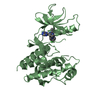
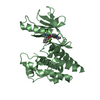
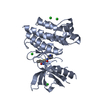


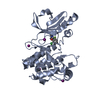
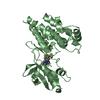
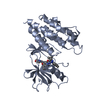
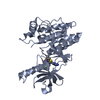
 PDBj
PDBj








